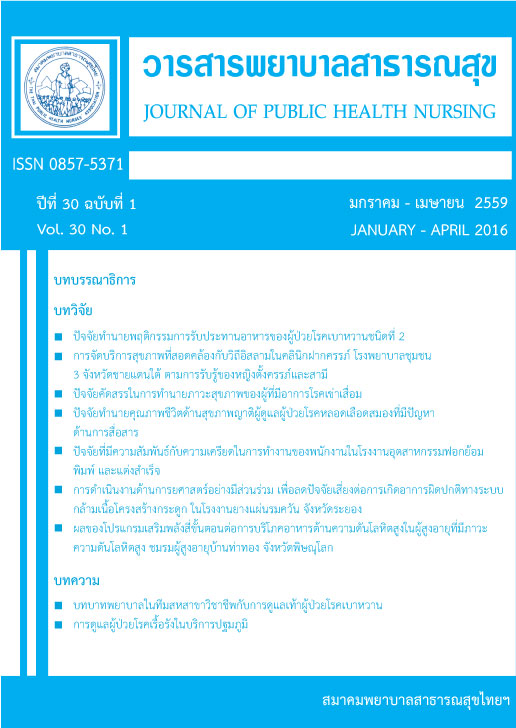การดำเนินงานด้านการยศาสตร์อย่างมีส่วนร่วม เพื่อลดปัจจัยเสี่ยงต่อการเกิดอาการผิดปกติ ทางระบบกล้ามเนื้อโครงสร้างกระดูก ในโรงงานยางแผ่นรมควัน จังหวัดระยอง*
Keywords:
การดำเนินงานด้านการยศาสตร์อย่างมีส่วนร่วม, อาการผิดปกติทางระบบกล้ามเนื้อโครงสร้างกระดูกโรงงานยางแผ่นรมควันAbstract
การดำเนินงานด้านการยศาสตร์อย่างมีส่วนร่วม เพื่อลดปัจจัยเสี่ยงต่อการเกิดอาการผิดปกติ
ทางระบบกล้ามเนื้อโครงสร้างกระดูก ในโรงงานยางแผ่นรมควัน จังหวัดระยอง
การวิจัยเชิงปฏิบัติการแบบมีส่วนร่วมนี้ มีวัตถุประสงค์เพื่อระบุ และลดปัจจัยเสี่ยงต่อการเกิดอาการผิดปกติทางระบบโครงร่างกระดูก และกล้ามเนื้อ (Work related musculoskeletal disorders: WMSD) เพื่อพัฒนารูปแบบในการลดปัจจัยเสี่ยงและแก้ไขปัญหาทางการยศาสตร์และศึกษาผลของการใช้รูปแบบที่พัฒนาขึ้น กระบวนการผลิตยางแผ่นรมควัน ต้องใช้แรงงานคนเป็นหลักซึ่งพนักงานต้องสัมผัสปัจจัยคุกคามทางการยศาสตร์ ทำให้เกิด WMSD จึงมีความจำเป็นอย่างยิ่งในการลดปัจจัยเสี่ยงและแก้ไขปัญหาทางการยศาตร์ในพนักงานกลุ่มนี้ กลุ่มตัวอย่าง คือ ผู้บริหาร หัวหน้างาน พนักงานฝ่ายผลิตระดับปฏิบัติงาน จำนวน 80 คน คัดเลือกจากโรงงานยางแผ่นรมควันขนาดเล็ก 1 โรงงาน ที่เต็มใจเข้าร่วมการวิจัย กิจกรรมหลัก คือ 1) สร้างทีมการยศาสตร์ในโรงงาน ประกอบด้วย ผู้บริหาร หัวหน้างาน ตัวแทนพนักงาน 2) สัมภาษณ์ ความรู้ ความตระนัก อาการผิดปกติทาง WMSD ของพนักงานในช่วง 7 วันที่ผ่านมา วิธีการทำงาน ท่าทางการทำงาน 3) อบรมทีมงานด้านการยศาสตร์ เกี่ยวกับปัจจัยเสี่ยงและการแก้ไขปัญหาการยศาสตร์ให้แก่พนักงาน 4) อบรม พนักงานทุกแผนก หาแนวทางในการป้องกันแก้ไข WMSD 5) ดำเนินการแก้ไขปัญหาโดยการให้ความรู้แบบมีส่วนร่วม วิเคราะห์ปัจจัยเสี่ยงร่วมกันจาก วีดีโอการทำงานของพนักงาน ฝึกทักษะการยืดเหยียดกล้ามเนี้อ ปรับวิธีการทำงาน ท่าทางการทำงาน อุปกรณ์ 6) ประเมิน ความรู้ ความตระหนัก อาการผิดปกติทาง WMSD ของพนักงานในช่วง 7 วันที่ผ่านมา วิธีการทำงาน ท่าทางการทำงาน วิเคราะห์ข้อมูลด้วยสถิติพรรณนาได้แก่ ความถี่ ร้อยละ ค่าเฉลี่ย และส่วนเบี่ยงเบนมตรฐาน
ผลการดำเนินงาน ทีมการยศาสตร์ พนักงานร่วมมืออย่างดีกับทีมวิจัยทำงานตามกระบวนการดำเนินงานด้านการยศาสตร์ได้ทุกขั้นตอน พนักงานคะแนนเฉลี่ยความรู้และความตระหนักเพิ่มขึ้นกว่าก่อนให้ความรู้อย่างมีนัยสำคัญทางสถิติที่ระดับ .05 (t=4.543, p-value < .001), (t=13.877, p-value <.001) หลังการปรับปรุงการปฏิบัติงาน พบว่า จาก 18 กิจกรรม มี 11 กิจกรรมที่ระดับความเสี่ยงท่าทางการปฏิบัติงานลดลง คิดเป็นร้อยละ 61.0 กิจกรรมลอกยางและตัดตบแต่งแผ่นยางลดจากระดับความเสี่ยงสูงเป็นระดับความเสี่ยงปานกลาง และมีคะแนนเฉลี่ยความรุนแรงของอาการเจ็บปวดลดลงกว่าก่อนปรับปรุงการทำงาน อย่างมีนัยสำคัญทางสถิติที่ระดับ .05 (t=8.891, p-value <.001).
ข้อเสนอแนะจากผลการวิจัย โรงงานทำยางแผ่นรมควันควรนำรูปแบบการดำเนินงานด้านการย-ศาสตร์ แบบมีส่วนร่วม ไปใช้ในการเฝ้าระวัง ป้องกัน และลดปัจจัยเสี่ยง และแก้ไขปัญหาอาการผิดปกติทางระบบโครงร่างกระดูก และกล้ามเนื้อ
PARTICIPATORY ERGONOMICS INTERVENTION TO REDUCE RISK FACTORS OF WORK RELATED MUSCULOSKELETAL DISORDERS IN SMOKED RUBBER PLANT, RAYONG PROVINCE
The objectives of this participatory action research were to identify, and reduce risk factors of work related musculoskeletal disorders (WMSD), developed model and implement model by workplace participation. The production process of smoked rubber using intensive labour force expose with ergonomic hazards which may lead to WMSD,
The research subjects included 1 administrator, and 7 supervisors and 80 workers, from small scale plant which is willing to participate. The research activities were 1) Ergonomic team building: administrator, supervisors, representatives of the staff; 2) interviewing about knowledge, awareness, and symptoms of WMSD with standard Nordic instrument and risk factors for WMSD with the Rapid Entire Body Assessment (REBA); 3) training ergonomic team about risk factors and solving ergonomic problems; 4) training staff from all relevant department in reducing risk factors for WMSD; and 5) finding out WMSD risk factors from VDO of working behavior of this plant, training muscle stretching, improving working procedure, working posture , and tools by participatory methods. 6) evaluating knowledge, awareness, and symptoms of WMSD, working procedure, working posture. The statistical analysis using descriptive statistics: frequency, percentage distribution, mean and standard deviation.
The ergonomic team, the staff, and the research team well participated throughout the entire processes. The results showed that mean scores of knowledge and awareness have significantly increased after the intervention, (t=4.543, p-value <.001) and (t=13.877, p-value <.001). There were some posture risk reductions of 11 activities out of 18 activities (61.0 percent) and significantly reduce musculoskeletal pain severity during the last 7 days (t=8.891, p-value <.001). Particularly, risk levels of separate rubber sheet above chest level, at waist level and clipping out foreign matter activities were reduce from high to moderate levels
This study suggested that the ergonomics intervention and developed model can be used for surveillance, protect WMSD and help reducing the risk factors of WMSD and can resolve some symptoms of the WMSD. Therefore, the smoked rubber plant and occupational health work group should apply the intervention through all the process for all workers at risk.
Downloads
Published
How to Cite
Issue
Section
License
บทความที่ตีพิมพ์และแผนภูมิรูปภาพถือเป็นลิขสิทธิ์ของวารสารพยาบาลสาธารณสุข (Thai Public Health Nurses Association)







